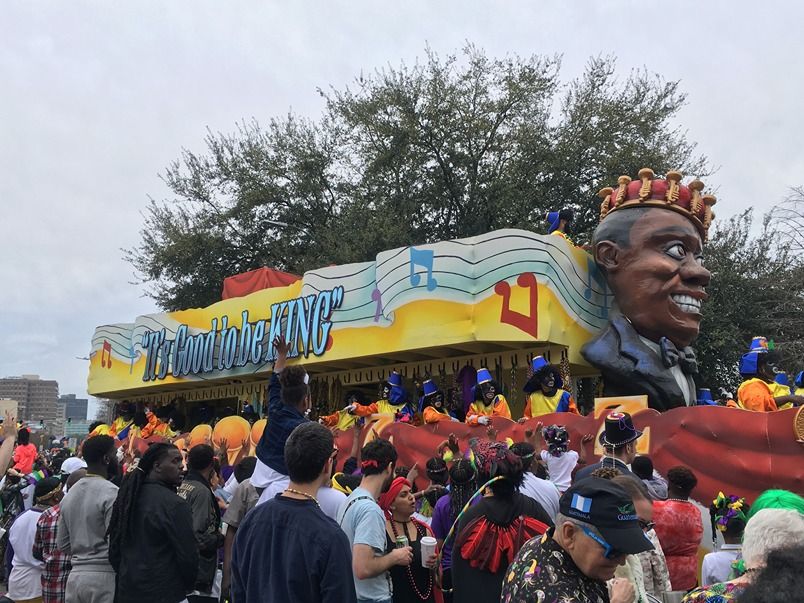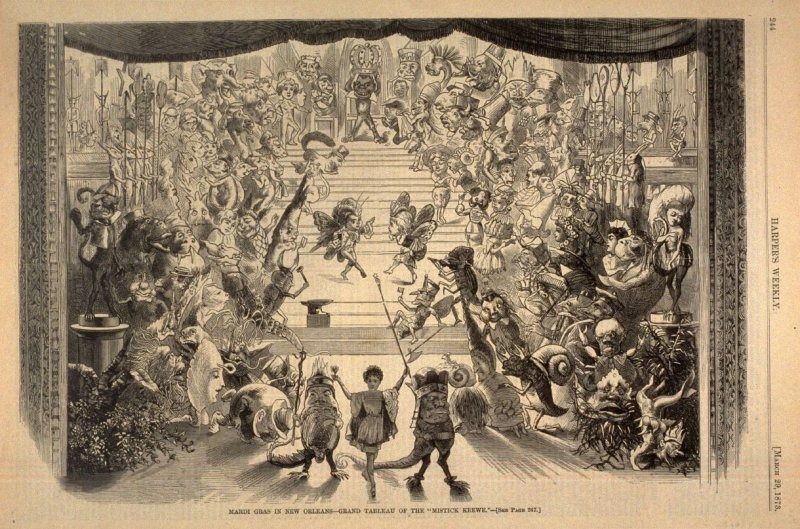From the Exclusion of Members to the Inclusion of Diverse Krewes
If there was ever a time where you vocalized your need to self-indulge via partying, drinking, and good times while everyone in the city is doing the same thing, then your friend definitely suggested going to New Orleans, specifically during Mardi Gras.
Mardi Gras Day is notoriously famous, and people flock to the Crescent City by the thousands to experience a unique time that cannot be replicated anywhere else. Brian Costello, author of Carnival in Louisiana: Celebrating Mardi Gras from the French Quarter to the Red River, writes, "The Carnival season and Mardi Gras day trace their roots from the Bacchanalia and Saturnalia ritual promiscuity of Roman times. With the spread of Christianity, similar revelry occurred during the period of carnival (Latin for 'farewell to flesh'), which extended from Twelfth Night (January 6, the feast of the Epiphany of Christ) to Shrove Tuesday (the day before Ash Wednesday and the ensuing forty-day penitential season of Lent)." Many people who do not live in New Orleans know about Mardi Gras Day; however, the true partying begins a month before Mardi Gras gets here—Carnival season.

While Mardi Gras Day is 40 days before Easter, Carnival season begins a little over a month before Mardi Gras Day. How did an extended party become engrained into the fabric of New Orleans' culture, and what's different about the first Carnival season compared to recent ones? Catch your beads, and grab a seat in your parade chair. We are comparing the first Carnival season in New Orleans to the present ones.
Picture This:
It's January 10, 1857, and you receive an invitation to meet with colleagues at a secret location to discuss plans for an extravagant event. By the time you go to the last meeting on February 8, 1857, you and 90 other members have named the newly developed krewe, picked a parade route, and planned a ball for later. In three weeks, Comus will be embarking on their first parade on the streets of New Orleans. The krewe secretly begins to send invitations to local newspapers without revealing their name. Locals pour into the streets the night of February 24, 1857 to witness the festivities. Your krewe is prepped in their costumes and masks, and the two floats that were intricately designed are ready to hit Tchoupitoulas Street. Charismatically, y'all begin walking through the streets of New Orleans, eager to see the crowd. Following the parade is an elegant ball "decorated with a profusion of hangings, wreaths, and festoons of flowers," as noted in the The Daily Crescent in 1857. With your krewe setting the precedent for Mardi Gras, this inspires other groups of people to create their own parade organizations and join the celebration.

Comus was the first and only krewe during the conception of Mardi Gras. The secret society, led by six white, Protestant businessmen, was formed with the intention to transform the once rowdy and violent Mardi Gras festivities into something much more sophisticated. The members dressed in costumes and floats were rolled into the streets—all while being illuminated by torch bearers—thus creating the concept of the modern Carnival season that we know and embrace today.
What's conspicuous about the first Carnival season versus recent ones is the unvarnished ghost that continues to haunt anything relating to America's evolution—the exclusion of minorities. The truth is simple. If you are not a white man, imagining yourself in 1857 planning a parade is the closest to a pleasant experience you will ever get from that era.
Mardi Gras was extremely segregated for a long time until December 19, 1991 when Councilwoman Dorothy Mae Taylor, the first Black female councilwoman in New Orleans, presented a city ordinance that would force all krewes to desegregate as a requirement to participate in Mardi Gras festivities. Of the four original krewes (Comus, Momus, Rex, and Proteus, Rex) sent invitations to three Black men, and the remaining krewes ceased parading. While Proteus reinstated themselves in 2000 after signing an affdavit stating that they do not discriminate against their members, Comus and Momus did not and remained off of the streets since. Some members of Comus formed more inclusive organizations, including Orpheus, debuting in 1993.

The unfortunate reality of this country is that racism will poke its head through the door to ruin things, even when the good times are rolling. The unwilling motivation to be inclusive in the genesis of the four original krewes prompted the first Black parading organization to emerge—the Krewe of Zulu. Inspired by the skit "There Never Was and Never Will Be a King Like Me," the original Zulu parade costumes consisted of grass skirts, black tights and turtlenecks, and blackface. Zulu was the first parading organization to feature a queen during Mardi Gras and featured the first queen's float in 1948. It's been said that the Zulu organization was created to poke fun at the white krewes. Whichever truth exists does not negate the cultural and communal impact Zulu has had since its conception. The first Black parading organization set the tone for diverse krewes including Oshun, Nefertiti, Femme Fatale, Tucks, Muses, and many more.
Modern-day krewes are far better examples of witnessing the spirit of New Orleans because they reflect the community more than the original "four horsemen." What began as a monoethnic, exclusive celebration expanded to a multi-layered, diverse, cultural phenomenon that has only gained more recognition thanks to the very people who were excluded from the original party. The 21st century Carnival season does not celebrate the voice of one but, instead, presents the space for the voices of all its people to be celebrated.

